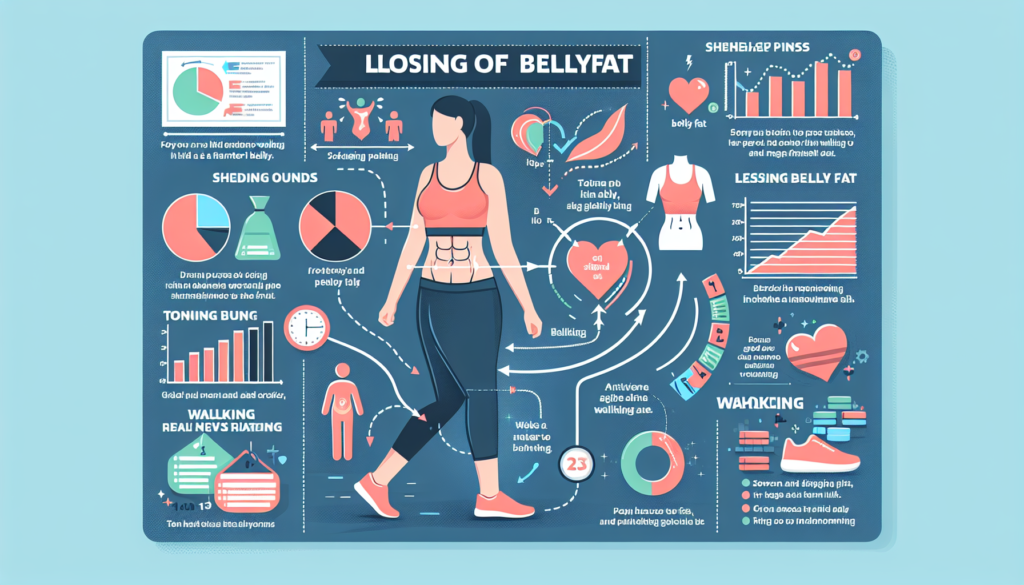Are you looking for a simple and effective way to shed that stubborn belly fat? Look no further – walking may be the answer you’ve been searching for. In this article, we will explore the benefits of walking as a means to lose belly fat and reveal how much you should be walking each day to achieve your goals. Say goodbye to complicated workout routines and hello to a daily stroll that can make a real difference in trimming your waistline. So put on your walking shoes and get ready to discover the power of this low-impact exercise.

Choosing the Right Walking Routine
Setting Your Daily Walking Goal
When it comes to choosing the right walking routine, one of the first steps is to set a daily walking goal. This goal will depend on various factors such as your current fitness level, available time, and overall health. Aim to start with a goal that is achievable and realistic for you. For example, if you are new to walking, you may want to start with a daily goal of 30 minutes of brisk walking.
Determining the Duration of Each Walking Session
Once you have set your daily walking goal, it is important to determine the duration of each walking session. This will depend on factors such as your fitness level and available time. If you are a beginner, you may want to start with shorter sessions of 10 to 15 minutes and gradually increase the duration as you become more comfortable and fit.
Deciding on Walking Speed and Intensity
The speed and intensity at which you walk can have a significant impact on the effectiveness of your walking routine. While a brisk walking pace is generally recommended for weight loss, it is important to listen to your body and choose a speed and intensity that is comfortable for you. Aim for a pace that elevates your heart rate and makes you break a sweat, but still allows you to carry on a conversation.
Incorporating Different Walking Techniques
To make your walking routine more enjoyable and effective, consider incorporating different walking techniques. For example, you can try power walking, where you exaggerate your arm swing and take longer strides. Another technique to include is interval training, where you alternate between periods of walking at a moderate pace and periods of walking at a faster pace. These variations can help prevent boredom and keep your body challenged.
Optimizing Your Walking Program
Creating a Consistent Walking Schedule
To get the most out of your walking routine, it is important to create a consistent walking schedule. Set specific days and times for your walks and make them a priority in your daily routine. By establishing a routine, you are more likely to stick to your walking program and make it a habit. It can be helpful to schedule your walks at times when you are most likely to have the time and energy to commit to them.
Increasing Walking Frequency and Duration Gradually
As you become more comfortable with your walking routine, gradually increase the frequency and duration of your walks. Start by adding an extra day of walking each week and slowly increase the duration of your walks by a few minutes at a time. This gradual progression allows your body to adapt to the increased activity and helps prevent injury.
Adding Variations to Your Walking Routine
Adding variations to your walking routine can help keep you motivated and prevent plateauing. Consider walking on different terrains, such as hills or trails, to challenge your muscles in new ways. You can also try adding incline intervals to your walks by finding routes with varying elevations. These variations not only add excitement to your routine but also help target different muscle groups.
Challenging Yourself with Interval Training
Interval training is a great way to challenge yourself during your walking sessions. This involves alternating between periods of walking at a moderate pace and periods of walking at a faster pace or jogging. For example, you could walk at a brisk pace for 3 minutes, then increase your speed to a jog for 1 minute, before returning to a brisk walk. This can help boost your calorie burn and improve your cardiovascular fitness.
Planning Your Walking Routes
Finding Suitable Walking Paths
When planning your walking routes, it is important to find suitable walking paths that cater to your specific needs and preferences. Look for paths or trails that are well-maintained, well-lit, and safe to walk on. Consider parks, nature reserves, or dedicated walking paths in your community. These routes often offer scenic views and a tranquil environment that can enhance your walking experience.
Exploring Different Terrain for Variability
To keep your walking routine interesting and challenge your muscles in different ways, consider exploring different terrains. Walking on uneven surfaces such as gravel, grass, or sand can engage different muscles and provide a more comprehensive workout. Additionally, incorporating hills or inclines into your routes can increase the intensity of your walks and help burn more calories.
Considering Safety Measures
When planning your walking routes, always prioritize your safety. Choose paths that are well-lit, avoid secluded areas, and walk during daylight hours whenever possible. If you are walking alone, consider informing a friend or family member of your route and estimated return time. It is also advisable to carry a cell phone with you in case of emergencies.
Utilizing Treadmills or Track Walking
If outdoor walking is not feasible or convenient for you, consider utilizing treadmills or track walking as alternatives. Treadmills offer the benefit of being able to control speed and incline, making it easier to track your progress and challenge yourself. Track walking, on the other hand, allows you to walk in a controlled environment and provides a safe and predictable surface for your walks.
Supporting Your Walking Routine with a Healthy Lifestyle
Eating a Balanced and Nutritious Diet
To support your walking routine and maximize your results, it is essential to maintain a balanced and nutritious diet. Focus on consuming whole foods such as fruits, vegetables, lean proteins, whole grains, and healthy fats. These provide the necessary nutrients to fuel your walks and aid in recovery. Stay hydrated by drinking plenty of water throughout the day to optimize your performance.
Getting Sufficient Sleep for Optimal Fat Burning
Adequate sleep plays a crucial role in maintaining overall health and supporting fat burning. Aim for 7-9 hours of quality sleep each night to give your body the rest it needs to recover and repair. Quality sleep also helps regulate hormones responsible for appetite control, ensuring that you make healthier food choices throughout the day. Prioritize creating a relaxing sleep environment and establish a consistent bedtime routine.
Staying Hydrated during and after Walks
Proper hydration is vital for optimal performance during your walks and for promoting overall health. Drink water before, during, and after your walks to replenish fluids lost through sweat. If your walks are longer or in hot weather, consider carrying a water bottle with you. Staying hydrated helps maintain energy levels, supports joint health, and aids in digestion.
Incorporating Strength Training and Resistance Exercises
While walking is an excellent form of exercise, incorporating strength training and resistance exercises into your routine can further enhance your results. Building muscle mass through strength training helps boost your metabolism and increase fat burning even at rest. Include exercises such as squats, lunges, push-ups, and planks to target major muscle groups. Aim for two to three strength training sessions per week, alternating between different muscle groups.

Monitoring and Tracking Progress
Keeping a Walking Journal
Keeping a walking journal allows you to track your progress, set goals, and stay motivated. Record the duration, distance, and intensity of your walks, as well as any observations or achievements you want to note. Additionally, you can use the journal to set weekly or monthly goals and celebrate milestones along the way. This visual representation of your progress can serve as a constant reminder of how far you’ve come.
Utilizing Fitness Trackers or Apps
Fitness trackers and apps are excellent tools for monitoring and tracking your walking progress. These devices can track your steps, distance covered, calories burned, and even heart rate. Look for features that align with your goals and preferences, whether it’s real-time tracking, GPS mapping, or integration with other fitness apps. By having access to data on your walking performance, you can make informed decisions about your routine and monitor your progress over time.
Tracking Your Steps and Distance Covered
Tracking your steps and distance covered can be a great motivational tool and help you stay on track with your walking goals. Aim for a minimum of 10,000 steps per day, which is considered a healthy level of physical activity. As you progress, you may want to gradually increase this target to continue challenging yourself and burning more calories.
Documenting Changes in Body Measurements
In addition to tracking your walking progress, it can be beneficial to document changes in your body measurements. This can include measurements of your waist, hips, thighs, and other areas of interest. Over time, you may notice changes in these measurements, such as a decrease in waist size or increased muscle tone. These visual markers can provide added motivation and serve as a reminder of the progress you are making.
Overcoming Challenges and Staying Motivated
Dealing with Weather Conditions
Weather conditions can pose challenges to a consistent walking routine. However, with some planning and flexibility, you can overcome these obstacles. Invest in appropriate clothing and gear for different weather conditions, such as rain jackets, lightweight layers for hot weather, or cold-weather accessories. Alternatively, consider indoor walking options during inclement weather, such as walking in a mall or joining a local gym with indoor walking tracks.
Finding Walking Buddies or Joining Walking Groups
Walking with others can make your walks more enjoyable and help you stay motivated. Consider finding walking buddies or joining walking groups in your community. Not only can you engage in pleasant conversations and share experiences, but you can also benefit from the added accountability and support. Plus, spending time with like-minded individuals who share your fitness goals can be highly motivating.
Listening to Music or Podcasts for Entertainment
Listening to music or podcasts during your walks can provide entertainment and help pass the time. Create a playlist of your favorite upbeat songs or find podcasts that interest you. Music with a faster tempo can also help keep you motivated and maintain a consistent walking pace. Just be sure to stay aware of your surroundings and only use earphones at a safe volume.
Rewarding Yourself for Milestones Achieved
Rewarding yourself for milestones achieved can help keep you motivated throughout your walking journey. Set small milestones, such as reaching a certain number of continuous days of walking or achieving a specific distance goal. Treat yourself to something you enjoy, whether it’s a pampering session, new workout gear, or a day off for rest and relaxation. These rewards serve as a well-deserved recognition of your hard work and progress.
Seeking Professional Guidance
Consulting with a Doctor or Nutritionist
Before starting any exercise or weight loss program, it is advisable to consult with a healthcare professional or nutritionist. They can provide personalized guidance based on your individual health needs and help ensure that walking is a safe and suitable activity for you. They can also offer recommendations on nutrition, hydration, and any additional strategies that may enhance your results.
Hiring a Personal Trainer or Fitness Coach
If you feel the need for personalized guidance and support, consider hiring a personal trainer or fitness coach. These professionals can provide expert guidance on creating a customized walking routine tailored to your goals and fitness level. They can also help you with proper form, technique, and progression, ensuring that you are maximizing the benefits of your walking program.
Joining Weight Loss Programs or Support Groups
Joining weight loss programs or support groups can provide a sense of community and accountability throughout your walking journey. These programs often offer resources, education, and support to help you reach your goals. Sharing your experiences, challenges, and successes with others who are on a similar path can provide valuable motivation and encouragement.
Considering Other Fat Reduction Techniques
While walking is an effective way to lose belly fat, it is important to consider other fat reduction techniques if you have specific goals or conditions. Consult with a healthcare professional or seek guidance from an experienced aesthetician or cosmetic specialist who can recommend additional treatments or procedures that may help you achieve your desired results.
Combining Walking with Strength Training and Cardiovascular Exercises
Understanding the Benefits of Strength Training
Strength training is a valuable addition to your walking routine as it helps build lean muscle mass, improves metabolism, and enhances overall strength and endurance. Consider incorporating exercises such as weightlifting, bodyweight exercises, or resistance band workouts. Aim for two to three strength training sessions per week, targeting different muscle groups each time.
Incorporating Cardiovascular Exercises for Overall Fitness
While walking itself is a cardiovascular exercise, incorporating additional cardiovascular exercises can provide additional benefits for overall fitness. Consider activities such as cycling, swimming, or aerobic classes to elevate your heart rate and challenge your cardiovascular system. Mixing different types of cardiovascular exercises with your walking routine can help prevent boredom and improve your overall fitness level.
Creating a Balanced Exercise Routine
To create a balanced exercise routine, aim for a combination of walking, strength training, and cardiovascular exercises. This well-rounded approach ensures that you are targeting different aspects of fitness and reaping the benefits of each. Incorporate rest days to allow for recovery and listen to your body’s cues to prevent overtraining and injury.
Burning More Calories During Your Walks
Wearing Comfortable Exercise Clothes and Shoes
To optimize your calorie burn during your walks, wear comfortable exercise clothes and supportive shoes. Choose moisture-wicking fabrics that allow for airflow and keep you cool. Invest in a good pair of walking or running shoes that fit properly and provide adequate support and cushioning. Comfortable attire allows you to move freely and maintain good form, ultimately helping you burn more calories.
Using Weights or Resistance Bands for Added Effort
Incorporating weights or resistance bands into your walking routine can add an extra challenge and increase calorie burn. Consider using hand weights or wearing a weighted vest during your walks to increase the intensity and engage your upper body. Resistance bands can be used to add resistance to your lower body exercises, such as lunges or squats, during your walking breaks.
Incorporating Interval Training and HIIT into Your Walks
Interval training and high-intensity interval training (HIIT) are effective ways to boost calorie burn during your walks. Incorporate short bursts of high-intensity efforts, such as a 30-second sprint or fast-paced walk, followed by a recovery period of walking at a moderate pace. Repeat these intervals throughout your walk to increase the overall calorie expenditure and improve cardiovascular fitness.
Maximizing Calorie Burn by Maintaining Proper Form
To maximize calorie burn during your walks, focus on maintaining proper form throughout your walking sessions. Keep your posture upright, engage your core muscles, and swing your arms naturally. Take longer strides and push off from your toes, engaging your glutes and hamstrings. By maintaining good technique, you optimize the engagement of your muscles and increase calorie burn.
Maintaining Long-Term Results
Adopting Walking as a Part of Your Lifestyle
For long-term results, it is essential to adopt walking as a part of your lifestyle rather than a temporary solution. Embrace walking as an enjoyable form of exercise and a means of transportation whenever possible. Look for opportunities to incorporate walking into your daily routine, such as walking to work, taking the stairs instead of the elevator, or parking farther away from your destination. By making walking a regular part of your life, you can maintain your progress and enjoy its myriad of benefits.
Enjoying the Mental and Emotional Benefits of Walking
Walking not only has physical benefits but also provides numerous mental and emotional benefits. Use your walking sessions as a time for reflection, stress relief, and self-care. Enjoy the scenery, listen to nature sounds, or practice mindfulness while walking. Being present in the moment can help reduce stress levels, improve mood, and enhance overall well-being.
Setting Realistic and Achievable Goals
When it comes to maintaining long-term results, setting realistic and achievable goals is crucial. Avoid setting overly ambitious goals that may be difficult to sustain in the long run. Instead, focus on small, attainable goals that you can consistently achieve. As you meet these goals, gradually challenge yourself with slightly more ambitious targets. Celebrate each milestone as you progress and acknowledge the effort you put into reaching them.
Making Adjustments to Your Walking Routine When Needed
As you progress on your walking journey, it is important to make adjustments to your routine when needed. Your body may adapt to your current routine over time, leading to a plateau in your progress. To continue seeing results, you may need to increase the intensity, duration, or frequency of your walks. Listen to your body and make adjustments accordingly, while also being open to trying new walking techniques or routes to keep your routine fresh and challenging.
In conclusion, choosing the right walking routine is essential for losing belly fat and achieving your fitness goals. By setting a daily walking goal, determining the duration and intensity of each walking session, incorporating different techniques, and optimizing your walking program with consistent schedules and variations, you can maximize the effectiveness of your walks. Planning your walking routes wisely, supporting your walking routine with a healthy lifestyle, monitoring and tracking your progress, overcoming challenges and staying motivated, seeking professional guidance when needed, and combining walking with strength training and cardiovascular exercises further enhance your results. By employing these strategies and maintaining a long-term mindset, you can successfully lose belly fat and enjoy the numerous benefits walking has to offer.


